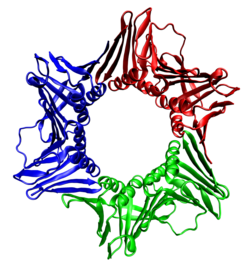Proliferating Cell Nuclear Antigen
| Proliferating Cell Nuclear Antigen | ||
|---|---|---|

|
||
| Ribbon model of the PCNA trimer according to PDB 1AXC | ||
|
Existing structural data: s. UniProt |
||
| Properties of human protein | ||
| Mass / length primary structure | 261 amino acids | |
| Secondary to quaternary structure | Homotrimer | |
| Identifier | ||
| Gene name | PCNA | |
| External IDs | ||
| Occurrence | ||
| Parent taxon | Eukaryotes | |
| Parent |
| DNA replication factor C complex |
| Gene Ontology |
|---|
| QuickGO |
Proliferating Cell Nuclear Antigen (PCNA) is a protein that surrounds the DNA as a ring during eukaryotic DNA replication (a so-called ring clamp protein ). Only with PCNA is it possible for the entire DNA to be replicated at high speed and without major interruptions during the S phase of the cell cycle .
genetics
The PCNA gene is located on chromosome 20 in humans . So far, two transcription variants are known which encode the same protein. The promoter area contains binding sites for the transcription factor E2F . Pseudogenes of this gene have been discovered on chromosome 4 and the X chromosome.
structure
PCNA consists of 261 amino acids and has a molecular weight of approx. 28.7 kDa . The protein consists of three identical subunits (homotrimer) that form a ring and can bind to double-stranded DNA (ds-DNA) through a total of 12 symmetrically located α-helices .
function
In the context of eukaryotic DNA replication, short RNA primers are first synthesized on the unwound template strand with the aid of primase (RNA polymerase) (de novo synthesis). The primer-template hybrid thus formed is passed directly to the associated DNA polymerase α, which extends the RNA primer at the 3 'end and starts DNA synthesis. The primers thus consist of 8-10 ribonucleotides ( RNA ) at the 5 'end and about 20 deoxynucleotides ( DNA ) at the 3' end . The 3 'end of the primer thus forms a section with ds-DNA. This transition from the ds-DNA at the primer end to the single-stranded DNA (ss-DNA) of the template strand is recognized by the replication factor C ( RF-C ), which attaches the PCNA ring clamp. The replicative DNA polymerases δ (on the following strand) and ε (on the leading strand) bind to PCNA and extend the primer - either until they hit the next Okazaki fragment (following strand) or until the next replication bubble (leading strand). During the entire elongation phase, PCNA remains bound to the DNA polymerase and prevents its dissociation from the DNA strand. Only when the last deoxynucleotide has been inserted does the polymerase fall off and can otherwise bind to PCNA again.
In the case of DNA damage, the tumor suppressor p53 causes the increased formation of the CDK inhibitor p21 . Among other things, p21 can bind to the PCNA ring clamp, which leads to an immediate stop of the replication. This gives damaged cells time for DNA repair, which prevents altered genetic material from being passed on to daughter cells.
PCNA also binds to DNA polymerase δ when it is recruited for DNA repair . This is done primarily to fill the single strand gaps that arise in the course of nucleotide excision repair (NER). In this case, PCNA is monosumoylated at lysine 164, whereas it carries a ubiquitin building block at the same location during replication .
The charge factor RF-C belongs to the class AAA + ATPases .
evolution
PCNA is functionally analogous to beta-clamp in bacteria. The beta-clamp also binds to the DNA with 12 symmetrically positioned α-helices, but - unlike PCNA - is a homodimer . This homodimer consists of two molecules of the β subunit of DNA polymerase III . The beta-clamp is loaded onto the DNA by the so-called γ complex. The γ-complex with its five subunits can be viewed as an analogue to RF-C in eukaryotes.
Individual evidence
- ↑ Orthologist at OMA
- ↑ a b Gene Cards: PCNA
- ↑ Egelkrout EM, Mariconti L, Settlage SB, Cella R, Robertson D, Hanley-Bowdoin L (2002). "Two E2F elements regulate the proliferating cell nuclear antigen promoter differently during leaf development". Plant Cell 14 (12): 3225-36. doi : 10.1105 / tpc.006403 . PMID 12468739 .
- ^ H. Lodish et al .: Molecular Cell Biology , Sixth Edition, WH Freeman and Company, New York 2008
- ↑ Joachim Rassow, Karin Hauser, Roland Netzker, Rainer Deutzmann: "Duale Reihe: Biochemie" p. 428, 3rd completely revised and expanded edition, Thieme Verlag 2012, ISBN 978-3-13-125353-8
- ↑ a b c d e Rolf Knippers: Molecular Genetics , 9th completely revised edition, Thieme Verlag 2006, ISBN 3-13-477009-1
- ↑ Hoege C, Pfander B, Moldovan GL, Pyrowolakis G, Jentsch S: RAD6-dependent DNA repair is linked to modification of PCNA by ubiquitin and SUMO . In: Nature . 419, No. 6903, September 2002, pp. 135-41. doi : 10.1038 / nature00991 . PMID 12226657 .
Web links
- reactome: Loading of PCNA - Sliding Clamp Formation
- reactome: Interaction between FEN1 and PCNA
- Blackburn / Seidel / reactome: Formation of Processive Complex on the C-strand of the telomere
- Blackburn / Seidel / reactome: Disassociation of Processive Complex and Completed Telomere End